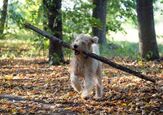Seeing my dogs running full-out across an open field always makes me smile. It’s a level of joy we aim for. However, finding the best place to let them run and play can be challenging. While a grassy field or private property is an amazing find, they aren’t always convenient, especially if you live in the city.For many, the local dog park seems like the most accessible option. These dog-specific spaces are often marketed as the perfect solution for dogs to burn energy and practice their socialization skills. However, if you’ve been researching the topic, you’ve likely noticed that the subject is very polarizing. Many trainers and behaviorists are speaking up about the potential risks of bringing dogs to these spaces, raising major concerns for those considering them.This raises an important question: How do you decide if a dog park is actually a good fit for the unique needs and personality quirks of your dog?In this post, I will deep dive into both the pros and cons of dog parks. It will be a neutral look at the key benefits and the very real risks associated with off-leash dog exercise areas, allowing you to make an informed decision. There is no “right” answer. The best choice is always the one that’s right for your individual dog!The “Pros”: Benefits of Visiting the Dog ParkWhen the dog park environment works well, it can offer some incredible benefits for your dog’s physical and mental health. The concept truly makes sense! These advantages are often why dedicated dog parents are drawn to the idea in the first place.A Place to Release EnergyFor many dogs, particularly those living in urban or suburban locations without a large, securely fenced yard, the dog park is one of the only places they can truly run free. This isn’t just about a structured walk or fun sniffari; it’s about unrestricted opportunities to run, gallop, chase, and reach their top speeds.This type of vigorous, off-leash activity may not be essential for every dog, but for high-energy breeds and young adults, it goes a long way to help address their needs. When a dog can burn off pent-up energy, they are far less likely to start engaging in boredom-driven behaviors at home, such as chewing furniture and shoes, excessive barking, or destructive mischief.Some high-energy dogs that may require more exercise to meet their physical needs include: Australian Cattle Dogs Border Collie Australian Shepherd Jack Russell Terrier Siberian Husky Belgian MalinoisSocialization OpportunitiesOne of the most significant benefits many bring up related to the use of dog parks is the opportunity for socialization with other dogs. Socialization itself, when introduced properly, is extremely valuable. Dogs are social animals, and interacting with other dogs allows them to practice and refine their species-specific communication. It allows them to learn to “speak dog” fluently by encountering different play styles, temperaments, sizes, and breeds.This helps many dogs to become more comfortable and neutral around unfamiliar dogs. They learn key social skills like initiating play, accepting invitations to engage with others, and most importantly, recognizing and respecting social cues like when to back off, when to be submissive, and how to signal that they want to play.For a well-adjusted dog, positive dog park visits can build confidence and help them stay calm and balanced when meeting new dogs while out and about.Mental Stimulation and EnrichmentBeyond the physical workout, a trip to the dog park is also an excellent opportunity for much-needed mental enrichment. Your dog’s brain is constantly engaged during their visit by the sheer volume of new sights, sounds, and smells. Visiting new and unfamiliar environments like this is great for your dog’s mental health.The dog park is a constantly changing experience of other dogs, toys, people, and smells, requiring your dog to take everything in quickly and make regular snap decisions. This mental “work” is just as tiring and fulfilling as physical exercise, if not more so.Additionally, a dog park can also help to create a sense of community for dog parents. It’s one of the few places you can connect, share tips, trade stories, and make new dog-loving friends. This sense of connection can help many aspects of life with a dog (especially if you’re struggling with a challenge and feeling alone).The “Cons”: Risks and Challenges of the Dog Park While there is no debating the fact that dog parks offer many potential benefits, experts recommend approaching these areas with caution. For some dogs, the risks and challenges of these locations will outweigh the rewards. This is where a neutral assessment of whether a dog park is right for your dog is so important. Many of these drawbacks are serious considerations when considering a dog’s long-term health and behavioral stability. Health and Safety Concerns With many dogs coming together and sharing resources in a single environment, there are several health and safety risks that may be elevated and should be considered. The first major concern is the potential for infectious diseases to be easily transmitted. The high number of dogs means a higher probability of spreading common illnesses, especially if other dog parents (who you have no control over) are choosing the bring their dog out even when they are sick. Diseases like kennel cough, canine influenza, and intestinal parasites such as Giardia and Coccidia are easily transmitted through shared water bowls, sniffed-up ground, or direct dog-to-dog contact. Even fully vaccinated dogs can be exposed to strains not covered by standard shots. That said, they do help to lower your dog’s risk, making up-to-date vaccinations (including optional vaccinations, especially in higher risk areas of the country) and dedication to parasite control essential before visiting a dog park. Beyond illness, there is a constant risk of injury. Despite the fun, dog parks are definitely accident-prone zones. Common injuries in these areas can range from minor scuffles to severe trauma. This also isn’t exclusive to aggressive or unfriendly dogs! Dogs running at full speed can collide, leading to bone fractures or ligament tears. Even seemingly harmless rough play can escalate quickly, resulting in bites. The environment itself can also be a hazard, with uneven surfaces, discarded trash, or foreign objects that could cause cuts or be ingested, leading to potentially life-threatening obstructions.

























